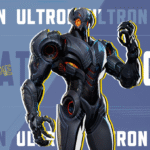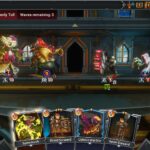For three decades, the name Doom has stood at the pinnacle of first-person shooters, consistently reinventing the visceral thrill of embodying a badass, super-powered one-man army against the relentless armies of Hell.

The series has masterfully evolved, moving from the foundational run-and-gun of the originals to the horror-tinged atmosphere of Doom 3, the modernized brutality of Doom (2016), and the high-speed combat puzzle of Doom Eternal.
Now, with Doom: The Dark Ages, developer id Software delivers yet another bold evolution, one that feels remarkably different from its immediate predecessor, offering a heavier, more grounded, yet equally exhilarating take on the iconic demon-slaying formula.
Stepping Into a Dark Sci-Fi Fantasy
Doom: The Dark Ages transports the player to a distinct, dark sci-fi fantasy setting, predating the events of Doom 2016. This narrative serves to fill in blanks within the extensive Doom universe, delving into the ancient history of the conflict between humanity and demons. While the Doom Slayer himself remains primarily a “vehicle for badassery” rather than revealing deep character origins, the story successfully fleshes out crucial factions like the defending Sentinels and the enigmatic, deity-like Maykrs.
The narrative feels more engaging than in previous entries, with human companions central to the plot, creating a sense that you are fighting alongside humanity in a colossal, all-out war against the demonic invasion.
The story takes players through a wide variety of striking landscapes, from sci-fi themed medieval castles to a welcome and intriguing trip to the Lovecraftian-inspired Cosmic Realm, featuring genuinely cool, mind-bending puzzles and creepy settings distinct from anything seen before. For a Doom game, this is undeniably the “strongest a Doom story has ever been,” even if the bar wasn’t set exceptionally high before; it moves beyond just being the Slayer against nameless forces and injects actual intrigue, particularly involving the mysterious Maykrs.
The Slayer’s Shield: A Game-Changing Addition
The most significant addition that fundamentally separates Doom: The Dark Ages from prior entries is the introduction of the Slayer’s Shield. This isn’t merely a defensive tool; it’s a versatile instrument that changes how you engage with the battlefield. Instead of being forced to rely solely on constant movement and evasive jumps like in Doom Eternal’s design, you are often encouraged to charge directly into danger with your shield raised.
The shield allows you to block incoming attacks – any attack colored red can be blocked until the shield’s energy is depleted. More importantly, attacks colored green can be reflected with a well-timed guard, not only dealing substantial damage back to the enemy but also stunning most monsters it hits, creating openings for follow-up attacks.
Even on the challenging Nightmare difficulty, the parry timing feels “very generous,” though it can be fine-tuned in the game’s options.
The shield’s utility extends to offense and mobility. It features a charging bash attack that allows the Slayer to quickly close the distance to enemies. This bash feels faster than the Super Shotgun’s grapple in Doom Eternal, can be used with any equipped weapon, and is on a relatively quick cooldown.
The combination of the shield’s defensive capabilities (blocking and stunning) and its offensive/mobility features (charging in or out) is what elevates The Dark Ages’ combat, maintaining a sense of speed and excitement even with the removal of rapid dashes and double jumps. The Slayer still feels incredibly mobile, but also like a heavily armored tank, complete with loud footsteps and a shockwave effect upon landing from a high jump.
More Than Just Defense: Shield Utility
The Slayer’s Shield’s functions don’t end with just blocking, reflecting, and bashing. Eventually, you gain the ability to toss the shield out, much like Captain America. When thrown at smaller fodder enemies, it can instantly decapitate them.
Against larger enemies, the thrown shield will continuously buzzsaw into them, incapacitating them for a short duration. This tossing ability is extremely useful, proving particularly potent against enemies like the Arachnotron, allowing you to interrupt their attacks, dash in, and quickly finish them off. These diverse shield abilities are key to surviving the game’s often intense fights.
A Revamped Combat Philosophy
Almost every enemy in Doom: The Dark Ages has some form of weakness, and a key departure from Doom Eternal is that these weaknesses are rarely weapon-specific. There’s less emphasis on rapid-fire weapon switching to exploit precise enemy weak points – no more mandatory swaps just to pop a grenade into a Cacodemon’s mouth or snipe the guns off a Revenant before changing back to other weapons for damage.
While Eternal’s “combat puzzle” approach was fun in its own way and will likely still be preferred by some players, The Dark Ages finds a way to be an “absolute blast” without demanding a “StarCraft pro’s level of APM” on harder difficulties. The combat feels more about adaptable tool usage (shield, new melee, varied weapons) in combination rather than strict sequences.
A Familiar Yet Evolving Enemy Roster
The demonic roster in Doom: The Dark Ages includes many of the usual suspects that have plagued the Slayer throughout the series – Imps, Hell Knights, Mancubi, Arachnotrons, and even the iconic Cyberdemon, largely behaving as expected. However, some enemies have received new visual “facelifts” to better match the medieval setting, such as the Pinkie, now appearing as a mount ridden by a demon archer.
The game also brings back demons not seen in recent entries, like the Vagary from Doom 3, appearing as a mini-boss. Overall, there’s a nice variety in the enemies, and even familiar foes have new tricks to better integrate them into The Dark Ages’ combat mechanics.
Exponential Enemy Counts
One immediately noticeable change in Doom: The Dark Ages is the sheer scale of the enemy encounters. id Software has “exponentially jacked up the number of on-screen nasties” relative to both Doom (2016) and Eternal. Battlefields feel like “all-out war against the minions of Hell,” with hundreds, seemingly thousands, of enemies closing in. This can initially lead to frustration, particularly with enemies spawning without warning or attacking from behind, but learning to use the shield bash to quickly disengage and create distance becomes a necessary adaptation.
A New Melee and Ammo System
The iconic Chainsaw, a staple since Doom (2016) for instantly killing enemies and recovering ammo, has been omitted in The Dark Ages. It is replaced by an all-new melee system that encourages players to get up close and engage in melee brawls. These brawls also serve to restore ammo. This new system aligns with the shield’s offensive capabilities, again prompting players to rush towards the fight rather than away from it for resources.
Ammo pickups for the melee attack are significantly more plentiful than the fuel for the Chainsaw was in previous games, resulting in running out of ammo far less frequently, which was a welcome change. While the raw satisfaction of sawing an Imp in half might be missed, the new system feels better suited to The Dark Ages’ combat flow.
The Tools of Annihilation
The arsenal in The Dark Ages features the familiar, satisfyingly punchy weapons Doom is known for, given an old-timey visual flavor. Stalwarts like the combat and Super Shotguns, a plasma rifle, and a weapon functioning like an assault rifle (firing railspikes instead of bullets) are present.
There’s also a single-shot, sniper-like weapon in the form of a satisfying steel ball launcher. The truly unique addition is the Skullcrusher Pulverizer, which behaves somewhat like a chaingun but boasts a “ridiculous spread” capable of shredding “a football field’s worth of fodder enemies,” making it particularly effective against the game’s massive hordes.
An interesting twist to the weapon system is the concept of “sister weapons.” Every gun has a companion weapon that shares the same ammo type and can be hot-swapped with the press of a button (e.g., a rocket launcher paired with a grenade launcher, or the wide-spread Pulverizer paired with the single-target Ravager).
This adds a “ton of variety in the gunplay,” and even if the game doesn’t strictly force swapping as Eternal did, it’s fun to jump between guns simply for the diverse ways to dispatch demons.
Importantly, every weapon retains its usefulness throughout the entire game, a credit to id Software’s design. Upgrades ensure even early weapons remain relevant – for instance, upgrading the combat shotgun allows it to ignite enemies for armor shards, or the Ravager to make them bleed health pickups.
Combining abilities, like throwing the shield into an enemy and then shooting the shield to make bullets ricochet and hit others, further diversifies the combat options. These abilities and weapons are introduced at a “measured pace” throughout the campaign, ensuring the gunplay feels consistently fresh.
Exploration and Progression
The level design in Doom: The Dark Ages actively encourages exploration. While varying in size, even the smaller stages feel “big by the series standards,” and the large levels are simply “gigantic.” They are described as “huge, open battlefields with tons of secrets, challenging enemy encounters, and more than a few breathtaking vistas.”
Finding upgrade currencies and traditional Doom collectibles like figurines and lore pick-ups fuels the desire to explore, feeding into the progression system where collecting gold allows you to afford new upgrades that alter existing abilities and make you want to experiment with them more.
Breaking Up the Action: Mechs and Dragons
Adding variety to the core first-person combat, Doom: The Dark Ages includes sections where the Slayer pilots giant mechs and even flies a dragon. While these sections, referred to as “mecha battles and flying sections where you pilot the Slayer’s dragon,” are described as somewhat “shallow” compared to the main gameplay, amounting to simple patterns of dodging and attacking, they are infrequent and brief enough to avoid disrupting the pacing.
They serve as cool spectacle moments, particularly in the cutscenes surrounding them, offering a change of pace from the standard demon-slaying action.
A Banger of a Soundtrack
As expected from a Doom title, The Dark Ages features a powerful heavy metal soundtrack. Described as another “banger,” the music is integral to the game’s energy and intensity. The soundtrack is so strong that the reviewer found themselves returning to certain levels just to listen to the music alone, turning down the game’s sound effects to fully appreciate the score without being overpowered by the sounds of combat.
Verdict: A New Flavor of Exhilaration
Far from being just “More Doom,” Doom: The Dark Ages successfully introduces a new flavor to the legendary FPS game series. It feels heavier and more grounded than Doom Eternal, yet loses none of the energy and exhilarating thrill the franchise is known for. The Slayer’s Shield is an “outstanding addition,” adding significant offensive and defensive options that, combined with the extensive and consistently useful arsenal of traditional Doom guns, provide a “ton of fun and exciting ways to dispatch the hundreds upon thousands of demons” you face.
With another high-quality heavy metal soundtrack backing excellent weapon, level, and enemy design, id Software has once again proven its mastery of the genre. The campaign, reportedly spanning over 20 hours (though another figure of 15 hours is also mentioned in the source text, suggesting a substantial length), is a brutal, exhilarating ride. id Software, like a Super Shotgun blast from point blank range, simply “don’t miss.”






